Victoria returns to the local tournament scene with gusto in the coming weeks. Yet for everyday golfers, the state’s allure has never waned and rarely has it been more appealing.
[Photographs by Gary Lisbon]
The percentage of space occupied by golf courses within Victoria’s 227,444 square kilometres would take some time and effort to calculate, but it would be a largely pointless exercise. Why? The contribution to the state made by our sport cannot be measured in mere area alone. Instead, one only need speak to any of the countless domestic and foreign visitors to the Garden State to develop a picture of its importance and to see the way Victorian golf is deified by those who make the journey to experience it.
The state is littered with an array of courses about which Victorians should feel tremendous pride. And it’s not just the vaunted collection known as the Sandbelt, or the mighty layouts of the Mornington and Bellarine peninsulas. North to south, east to west, Victoria is blessed with landforms, soils and a climate that most of the rest of the world could only dream of replicating. In a happy coincidence, there are 365 golf courses across the state – one for every day of the year. Here’s a baker’s dozen to add to your next Victorian golf itinerary.
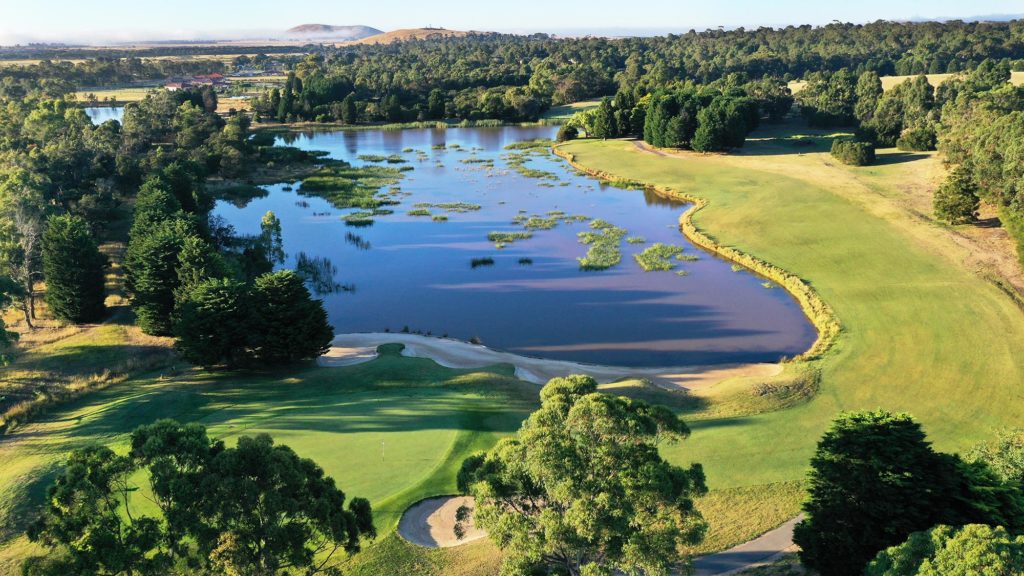
City lights
For sheer convenience, locations don’t come much better than Yarra Bend Golf Course, which has been a fixture within the Melbourne golf landscape for more than 80 years. Situated just 10 minutes’ drive from the CBD, proximity is just the first of Yarra Bend’s features. Next up is the picturesque setting. The course forms part of Yarra Bend National Park and is set in parkland that moves around the bend in the Yarra River.
The past decade has witnessed frantic activity at Yarra Bend. It began in 2010 when an injection of new investment underpinned by an ownership group with a vision to create a high-quality, community-focused public golf destination in this part of Melbourne. What spawned was the addition of a 58-bay indoor/outdoor driving range, a 36-hole mini-golf course and the BannLynchMcDade Golf Coaching Academy, led by Australia’s most successful coaching group. The 2019 addition of Toptracer Range Technology – making it one of the first in the country to do so – brought a data-driven practice experience to the city’s golfers. (Yarra Bend recently added Toptracer Mobile, which allows golfers to track their shots digitally, while hitting from a grass tee.) Growing into such a multi-functional facility has broadened the venue’s appeal and placed Yarra Bend in the top tier of public golf facilities.
The golf course itself offers an 18-hole, par-70 layout where the setting is ambient and the challenge ample for any level of golfer. Watch out for the par-4 fifth, which, as the toughest hole at Yarra Bend, has been known to wreck many a scorecard.
Venturing to the northern fringe of the city, it is not difficult to work out how Hidden Valley Resort got its name. The destination sits in a beautiful but sheltered little valley that doesn’t truly reveal itself until you’re in it. However, once there, the resort unfolds before you with an array of facilities and activities.
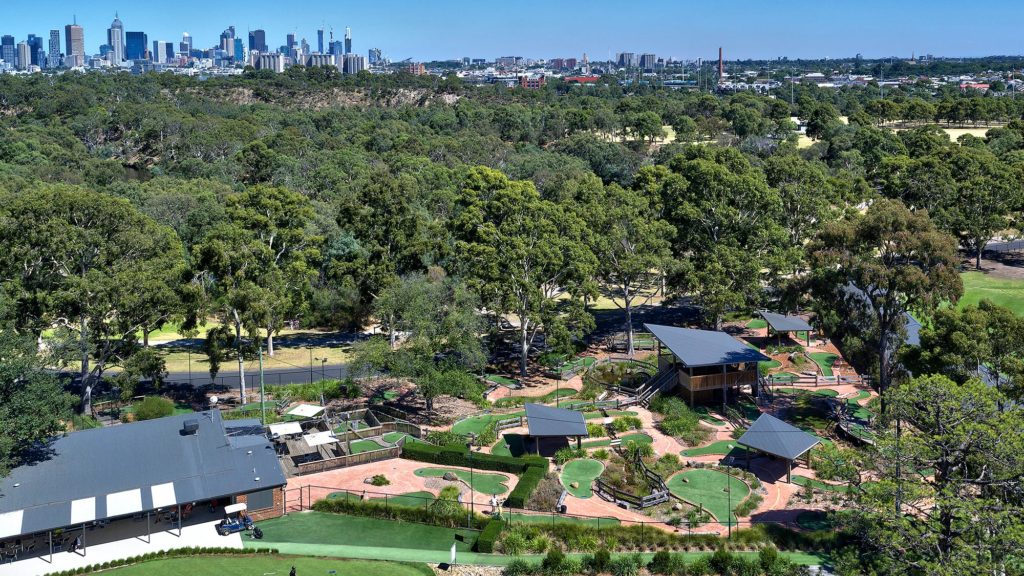
The resort sits between the regional towns of Wallan and Kilmore, 65 kilometres north of Melbourne but even closer to the airport. Hidden Valley has the twin advantages of being established but also refreshed – especially the clubhouse precinct, which was rebuilt in 2018. At one time the equestrian facility for the late businessman Robert Holmes à Court, six years ago the resort was acquired by the Arcadia Group, which has a background in retirement villages.
The Craig Parry-redesigned golf course is neat and tidy and measures a sneaky-long 6,498 metres from the back markers. The front nine is pleasant and does ease you in before the more spectacular back nine. A tough and twisting 10th hole precedes Hidden Valley’s answer to ‘Amen Corner’, where holes 13-15 feature doglegs over and around large water hazards and require numerous strategic decisions from the golfer. However, there can be no discussion about the Hidden Valley course without mentioning the par-3 18th, which stretches as long as 166 metres and plays to a green complex on an island. Many a good round has come undone with a watery finish.
Travelling in the opposite direction, Cranbourne Golf Club is still basking in the glory of hosting the Australian Amateur in March and April this year. The championships, won by West Australian Connor McKinney and New Zealand’s Fiona Xu, generated tremendous reaction from across the twin fields.
“We were overwhelmed with the feedback,” says general manager Andrew Kenny. “The players thoroughly enjoyed the experience, and all said the course was in magnificent condition, which is a credit to our staff.”
The Golf Australia organisation echoed that sentiment, as did Cranbourne’s members, who said they’d never seen their fairways looking better. It’s an experience that non-members can savour as well, with the club welcoming guest play at certain times. And you should, as the course ranked 79th in the country by Australian Golf Digest offers not only pristine surfaces but a solitudinous excursion through stands of trees that separate each fairway. Cranbourne is petite layout by modern standards at 6,194 metres but insists on accuracy throughout and where the bunkering is classic and not overdone.
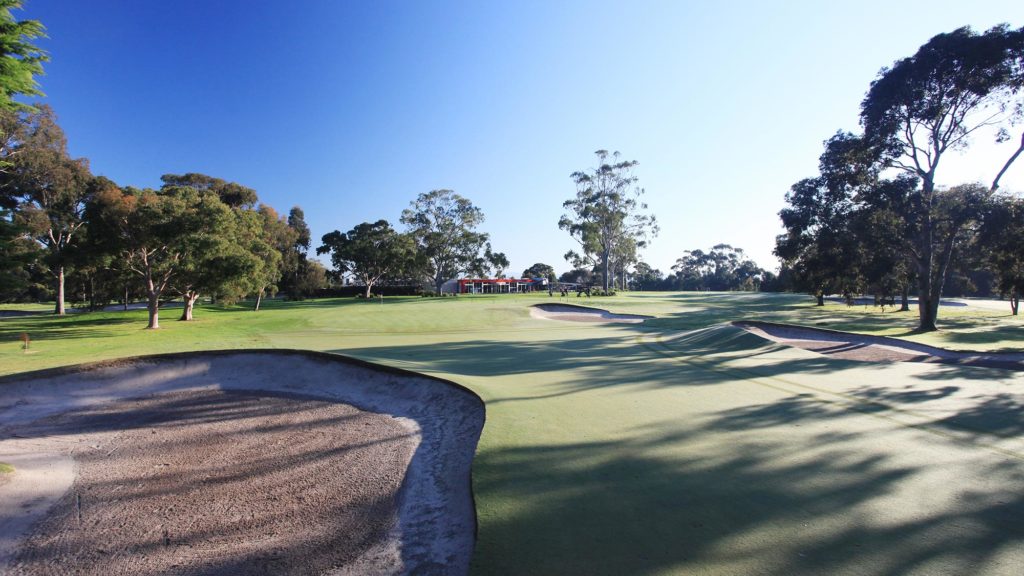
The full gamet
The Mornington Peninsula is an ideal place to show up with a healthy appetite for golf. With more than a dozen leading courses on the boot-shaped parcel of land – and a location wedged between a stunning bay and a roaring strait – it is the kind of destination where a fortnight’s stay can easily be justified.
Public-access courses don’t come much better than St Andrews Beach. American course architect Tom Doak has the knack of providing golfers with an abundance of room in which to work but somehow simultaneously using these vast open spaces to force players to handcuff themselves. St Andrews Beach is full of opportunities to score, openings so wide that the bold play almost has to be taken for it would feel too timid not to. And therein lies the genius in Doak’s addition to the region; he arms you with the weaponry to fire away but in most instances the ammunition will explode in your hands.
Part of an ambitious project that was initially intended to include 36 holes, St Andrews Beach today remains at 18 – but they are 18 tremendous holes. The layout is a diminutive 6,074 metres and the par figure on several holes feels half a shot out, luring golfers into a potentially foolish play one minute then sitting them on their backsides the next. The bunkering dotted across the huge expanses of fairway is exceptional. Numerous blowout bunkers litter the landscape, huge pits creating difficult recoveries as the unending thrust and parry between course and golfer goes on.
In the same neighbourhood is the 36-hole bonanza that is Moonah Links. The two-time Australian Open venue will this month return as the host of the Victorian PGA Championship (November 10-13) after staging two editions in 2021. A golf course devised with a ‘Home of Australian Golf’ and the Australian Open in mind, Peter Thomson’s Open course at Moonah Links is a supremely difficult test of execution. Immensely long, vulnerable to the winds whipping off nearby Bass Strait and cratered by innumerate pot bunkers, the Open course is about as tough as the game becomes.
Good things often come in pairs in golf, and the opening of the Legends course at Moonah Links added to that legacy. Three years younger than its sister Open course, the Legends is far less severe while remaining a stout examination. Also designed by Thomson Perrett (although Ross Perrett was the primary designer), the Legends works as a perfect companion layout in that it is markedly different to the Open course but in a complementary fashion.
It visits more enclosed valleys within the terrain before unfolding in open spaces more indicative of the Cups region of the Mornington Peninsula. The bunkering is a highlight of Perrett’s work on the Legends. Not pot-style in nature like next door, the sand instead takes on a more rugged, wild and eye-catching look – with smart strategy to their placement, which is one way the two courses do overlap. Within less than 200 hectares of space sit two exceptional but different golf courses.
Just down the road, Portsea Golf Club resides in that glorious space commonly known as ‘semi-private’. It’s a malleable term in golf parlance that essentially means there are members, and the membership certainly takes priority at times, but there are healthy sections of the timesheet available for visitors. And at Portsea, many of those visitors are overnight guests who stay in the 24-room hotel that forms part of the large, modern clubhouse.
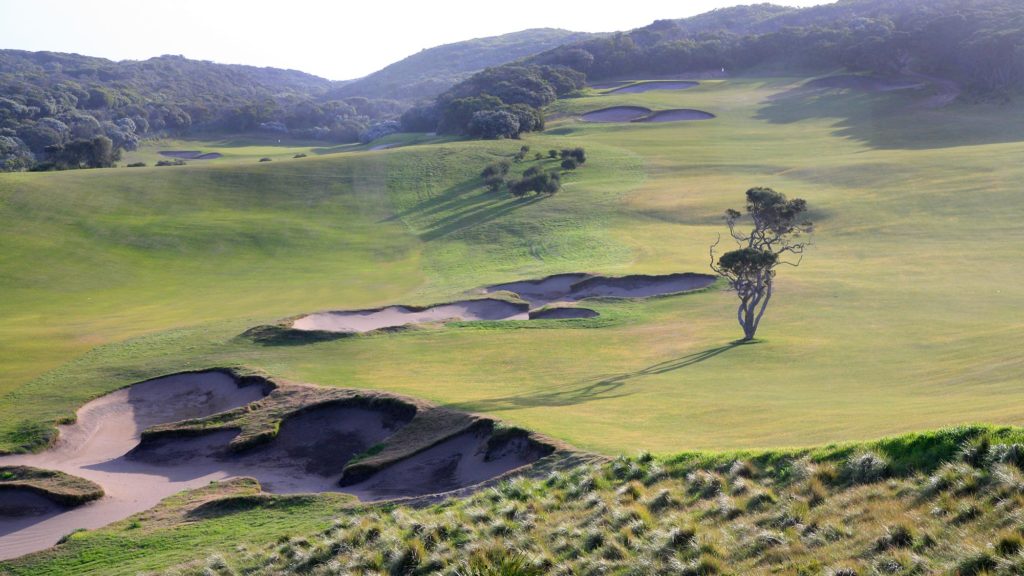
“We get a lot of people who come here and might play golf for a day,” says general manager Adam Hosie. “They may take a second day off, and then they’ll have a second round on day three. And that second day is spent exploring the Portsea headland and national park, having lunch at the Portsea pub – all those iconic locations, which there’s plenty to see and do there to keep someone entertained from a non-golf perspective. People who have visited for three and four-day stays have often commented on how much there is beyond the golf experience, to see and do in the local Portsea and Sorrento area.”
The Portsea layout presents a wondrous mix of short and long. There are brilliant short par 4s, most notably at the ever-strategic 10th and 15th holes, mixed with several strong two-shotters. The 395-metre fourth hole quite rightly takes the No.1 stroke index, but equally strong are the lengthy par 4s at the 14th, 17th and 18th. The first of the trio tumbles downhill to a fantastic green complex nestled into a hillside below the eighth and 10th tees, while the two closers flow back and forth across a strip of the course that yielded a pair of the best and sternest holes.
On your way out of the region, allocate time to tour Bay Views Golf Course at Rosebud. Managed by GSM Golf (as are St Andrews Beach, nearby Ranfurlie Golf Club and several others elsewhere in Victoria and in Queensland), Bay Views was known until 2015 as Rosebud Park but now owns a moniker more reflective of its sublime setting.
Characterised by impressive bunkering that hints at the site’s proximity to the Sandbelt, the scene-stealing attributes are without doubt the bay views on offer from several holes, the best of which come at the 12th and 13th holes. Nearby Port Phillip Bay might dominate the landscape, but
don’t let the exceptional vistas distract you from what is a wonderfully undulating layout. Managing the bounce of the ball and avoiding greenside runoffs are the keys to
finding success on the par-70 course.

Belles of the ball
Lonsdale Links is both old and new. The club on the Bellarine Peninsula will mark its 100th birthday on November 18 yet is less than two years removed from a complete rebirth of its golf course. Point Lonsdale Golf Links was established in 1922 by Messrs Nicholas and Pascoe when they purchased 45 acres of land at Point Lonsdale for 1,000 pounds to establish a new links course. Their thinking was that a golf course would be a good alternative to swimming when the weather was unsuitable.
Throughout the years, the club changed names and design. By 1931 it was Point Lonsdale Golf Links Club, in 1945 Lonsdale Golf Club and then to mark the most recent and game-changing redevelopment of the course and club, the name has sat as Lonsdale Links since late 2020. It signalled a new era for the club as renowned architects Ogilvy Cocking Mead redesigned the course as a deliberate throwback to an earlier age with template holes to make it a nostalgically challenging yet fun course, and one unique to Australia. The course was strategically designed to reveal more of itself each time you play. It draws inspiration from trailblazing architect Charles Blair Macdonald and his colleagues Seth Raynor and Charles Banks. There’s a Biarritz green at the second, a thumbprint-style depression within the 12th green, a reverse take of the Redan at 14 and even a nod to the famous Road Hole on the Old Course at St Andrews at the 16th.
Perhaps Lonsdale Links’ greatest asset is its overall playability. High handicappers and occasional golfers can navigate safe paths from tee to green on all holes, while the challenge is not diluted in any way for better players, even at a modest 5,505 metres.
The story of nearby Curlewis Golf Club should give hope to any Australian course that feels underappreciated or too hidden from view. It took the layout 48 years and the input of four separate course architects to break into Australian Golf Digest’s biennial Top 100 Courses ranking but has remained a ‘resident’ there since finally making the grade in 2018.
The 18-hole course – which is blessed with sandy terrain and shapes resembling the Melbourne Sandbelt – was originally designed by Vern Morcom on land purchased by East Geelong Golf Club in 1947. But 12 months later the development ceased after the bore water failed. The club leased the land for grazing until 1969 when mains water became available and 12 months later the course opened to the public. It has been a good golf course ever since, although there were problems with its condition due to drought in 2006 and 2007. Five years later the club installed its own water reclamation plant. But by 2015 Curlewis was struggling to survive financially, and the 60-hectare site was in danger of falling into the hands of developers before Lyndsay and David Sharp bought it. They engaged, on a long-term basis, renowned course architect Mike Clayton, who along with his colleagues made several improvements to the layout.
Yet perhaps the biggest continuing story at Curlewis began with the January 2018 opening of the $8 million The Range@Curlewis, which is just a kilometre up the road from the golf course. Among other things, The Range boasts state-of-the art driving bays and practice facilities, two-tiered mini-golf, a conference centre for 200, pilates classes, virtual golf, superb bistro and bar and a wonderful outdoor deck.
On the north-eastern tip of the bulbous peninsula, Portarlington Golf Club is another slice of the Sandbelt on the Bellarine. Several bunkers would look right at home at Kingston Heath, while the small greens and occasional stands of imposing pine trees are reminiscent of the top Melbourne courses. The design is solid, but the condition of the couch-grass fairways is the showstopper. Any Sandbelt course would be proud of these surfaces. But don’t take just our word for it; take it from a former Open Championship runner-up. Mike Harwood shot 64 to win the Legends Tour pro-am at Portarlington in February and called the course’s greens the best he’s ever putted on.
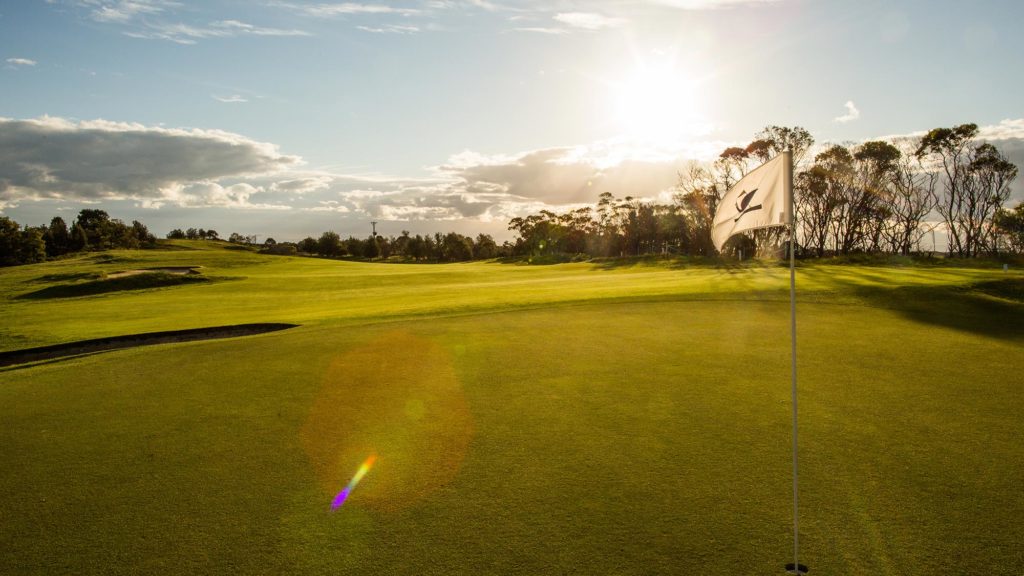
The run home from the 12th hole is strong, especially since course architect Tony Cashmore fortified the 12th a decade ago and brought out its Sandbelt-like qualities by emphasising the angles off the tee towards the bunker-lined fairway and again for the shot into the green. The 13th is a 241-metre par-4 that is so tempting it almost forces you into hitting driver from the tee, with the two strongest par 4s on the course following it. The 18th is a deceptive 318-metre downhiller where squeezing a drive between the left treeline and a small pond fronting the green is hard to do.
Nudging away from the Bellarine and starting the journey down the Great Ocean Road, it’s birdies you’ll seek but kangaroos you’re guaranteed to encounter at Anglesea Golf Club. Wedged into the hinterland above the coastline flanking the great thoroughfare, the course is heavily treelined and is emblematic of country golf in Australia. Not only because of the 300-odd Eastern Grey kangaroos that are so tied to the club’s reputation, but the native flora as well. The layout is challenging without being a toil, with many green complexes protected by a solitary bunker – the kind of target that infuriates when you fail to avoid the lone genuine obstacle in your path to the pin.
The course evolved nine holes at a time, starting with the Vern Morcom-designed front half in 1952. The Anglesea layout grew to 18 holes in 1961, while the acquisition of additional land a year later saw the original nine holes redesigned by 1968. And for those visitors truly taken by the vast number of ’roos on the course, the club hosts regular tours.
“The mobs are usually in groups of about 40 or so and they are a very family-oriented kind of animal,” says Les Cooper, who has been involved in the tours since they began in 2015. “During the breeding season, they congregate in their groups and there are usually quite a few joeys hopping about.”

Murray Meccas
OK, so we’re gilding the lily slightly here by tiptoeing across the border to two destinations that are technically in New South Wales. However, they’re so close to Victoria that you can almost touch it. In fact, in the case of Yarrawonga Mulwala Golf Club, you play right alongside Victoria as the Murray River acts as the edge of the fairway on one hole.
Yarrawonga Mulwala is one of several Murray double acts. Well, double-and-a-half, in fact, as it’s actually a 45-hole extravaganza with an underrated (but, it must be said, not underused) Executive nine. Yarrawonga can validly call itself a complete destination, so much so that if there were no other golf courses nearby golfers would be unlikely to need to leave. Aside from the abundant golf are various styles of accommodation, bistros/restaurants, tennis, bowls and croquet, a health and fitness centre and even a cinema.

The Murray course gets the nod as the superior layout, but the Lake offers more variety within its 18. It climbs up and down more than the almost dead-flat Murray course, with several sharp elevation changes at key points of the Lake course. Water is in play throughout but not in the abundance the name suggests, rather at selected and strategic points during the round.
Another potent double-header along the Murray is Rich River Golf Club Resort, and it’s especially worth visiting if you haven’t been there in a while. With the recent addition of an impressive mini-golf course, as well as an extensive internal renovation of the clubhouse plus a 51-lot estate now under construction, the off-course offerings are appealing even without considering what’s happening with the 36 holes.
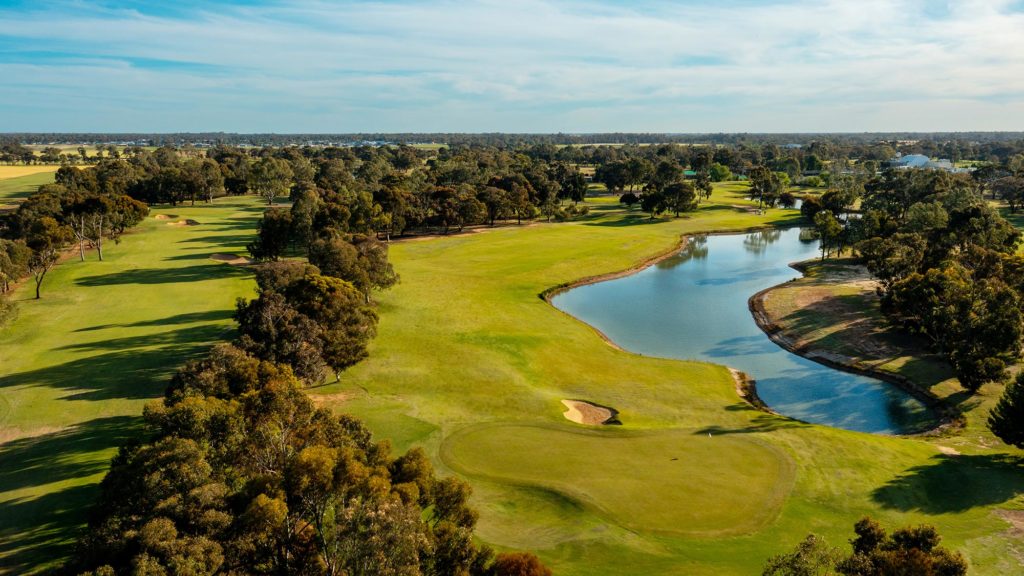
An irrigation upgrade to the East course is now complete with a similar project on the West due to finish in the coming months. Meanwhile, a masterplan penned by Thomson Perrett continues to enhance what has long been a popular stop along the river.
There is more activity on the horizon, with future plans for two new holes on the East course, a seniors living facility, an entertainment-based driving range, a short course, new four-and-a-half-star accommodation and further internal and external clubhouse renovations.
The Murray courses remain firm favourites but, much like the rest of the state, the offerings continue to get better with every visit. No wonder they say Victoria is the place to be.



